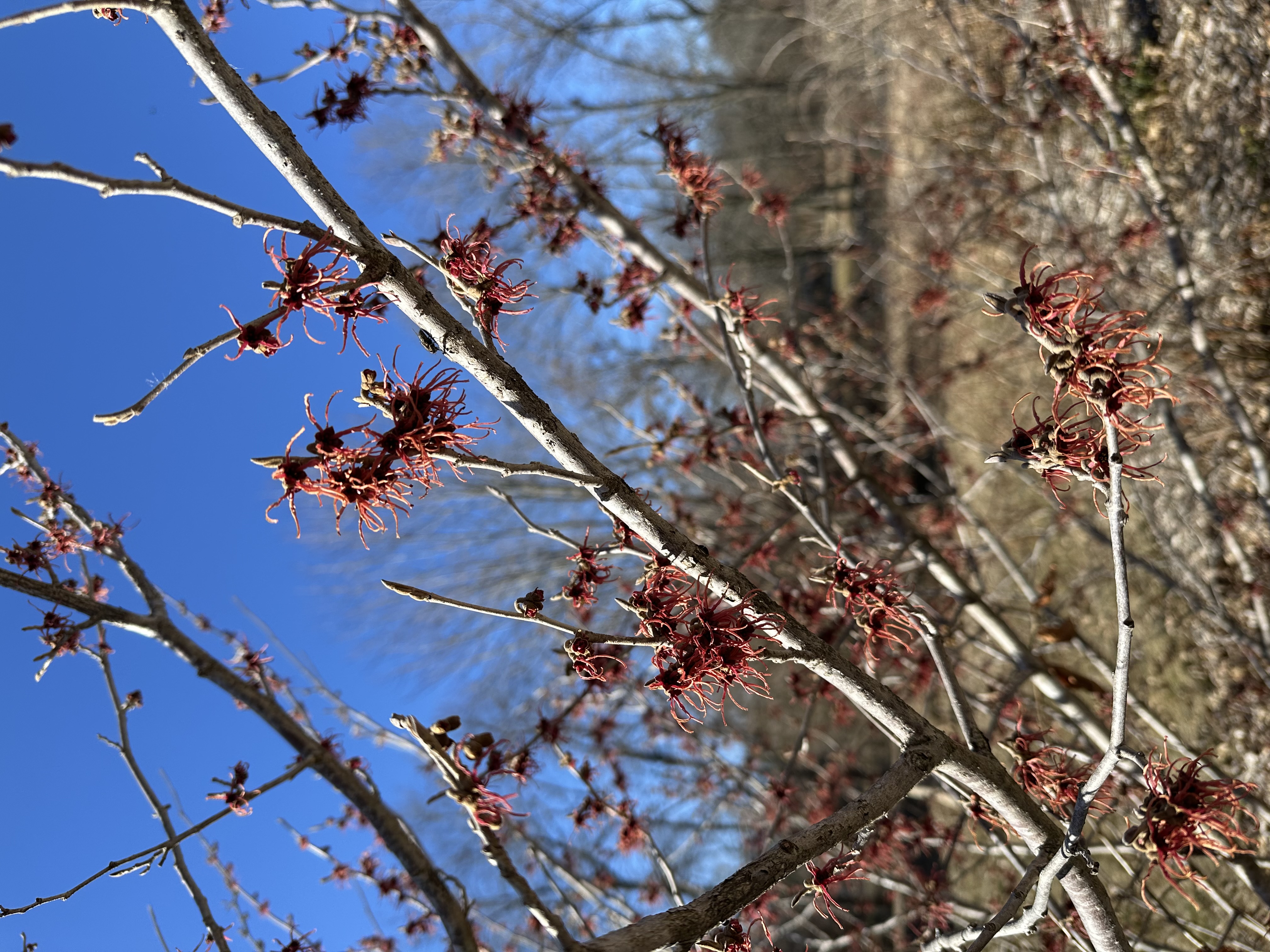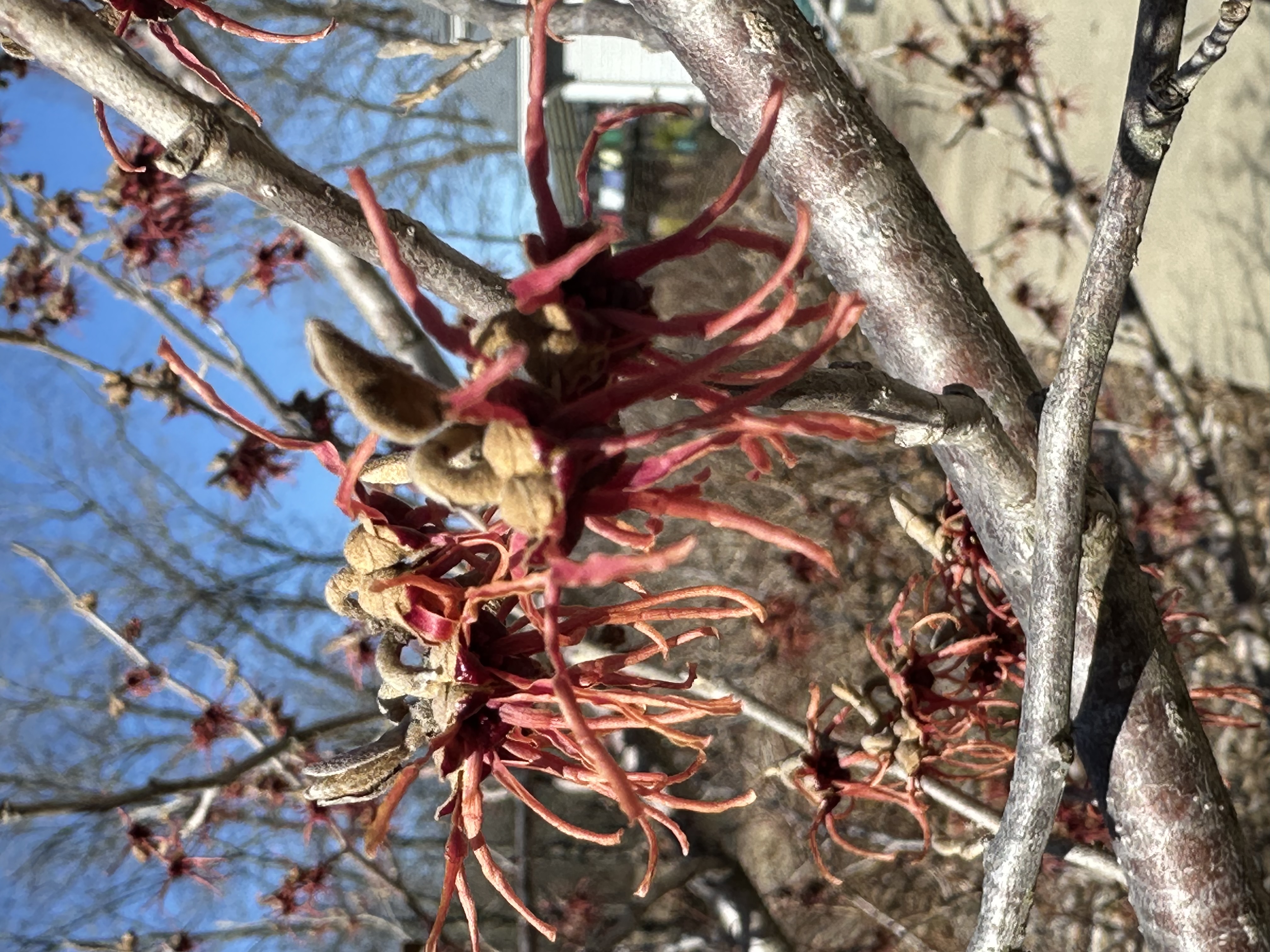I am not sure which I love more - birds and everything about them, or gardening. Luckily I never have to choose! This is your Public Forum, but I thought I would use it every now and then to recommend a plant for your garden. This month I cannot say enough good things about witchhazel. When I talk plants, I will use their common and also their botanical names. Common names can vary depending on where you live, but botanical names always remain the same. So if you ever want to check out what I am talking about at your local garden center or nursery, use the botanical name so you will get information on the exact same plant I am mentioning.
I have 3 witchhazels in my garden and love all 3. All witchhazel's can stand alone, be grouped in 3's or used as a mass planting, or they can be part of a hedge or a mixed shrub border. One of mine stands alone, 1 is part of a group of shrubs and 1 is in the middle of my long hedge of mixed shrubs running the length of our driveway.
Two are Common Witchhazel (Hamamelis virginiana). Both bloom yellow in late November-December. Unfortunately the flowers are not showy and the leaves are still on the branches so the small flowers are often obscured, but if you stick you nose in them, they do smell lovely - and what a treat on a cold December afternoon! And yes, they bloom here in central Illinois reliably every December - even though we are in gardening zone 5A. And all 3 have beautiful branching patterns - this is especially noticeable in winter. Witchhazels are hardy and will bloom down to zone 3.
These 2 Common Witchhazels are big - both were about 12' tall and about 6' wide (more about their size further down). The leaves turn a nice golden yellow in the fall and the leaves will hang onto the branches until spring. These are native from Canada to Georgia, west to Nebraska and Arkansas.
The third Witchhazel is Hamamelis x intermedia which is a cross between the Japanese Witchhazel (H. japonica) and Chinese Witchhazel (H. mollis). This is a large group of hybrids developed to keep the best characteristics of both. And this witchhazel is a real beauty and is blooming right now. Just keep in mind that if you have a garden of plants native to your area or you emphasize native plants, this plant is not considered native. However, both parent witchhazels were introduced into North America in the late 1800's so have been here a long time. And neither parent plant nor this hybrid are invasive. The 2 photos with this post are both of this hybrid witchhazel - I took them several days ago.
Ruffed Grouse and Northern Bobwhite will eat the small fruits. Also white-tailed deer - if deer are a problem in your garden, think twice about planting witchhazel. Beavers will also cut this to the ground for dam building. Beavers took our 2 native witchhazels one year. Nothing was left of them but pointed 4" stumps. And both plants had been over 10' tall. Amazingly, both regrew and are now at about 6' and still growing - you would never know this had happened to them. Resilient!
Amazingly even though witchhazel blooms during cold weather, it does rely on insects for pollination. Flies, beetles, and native bees and wasps. When it is bitterly cold, and the insects are not moving around, witchhazel does have the ability to self-pollinate.
If you are thinking about a big shrub or small tree, consider a witchhazel. They can be hard to find, but the effort will be worth it. I simply cannot imagine my garden without one. Or three!
If you have favorite plants, please share them with us - particularly which birds benefit. Linda
I am not sure which I love more - birds and everything about them, or gardening. Luckily I never have to choose! This is your Public Forum, but I thought I would use it every now and then to recommend a plant for your garden. This month I cannot say enough good things about witchhazel. When I talk plants, I will use their common and also their botanical names. Common names can vary depending on where you live, but botanical names always remain the same. So if you ever want to check out what I am talking about at your local garden center or nursery, use the botanical name so you will get information on the exact same plant I am mentioning.
I have 3 witchhazels in my garden and love all 3. All witchhazel's can stand alone, be grouped in 3's or used as a mass planting, or they can be part of a hedge or a mixed shrub border. One of mine stands alone, 1 is part of a group of shrubs and 1 is in the middle of my long hedge of mixed shrubs running the length of our driveway.
Two are Common Witchhazel (Hamamelis virginiana). Both bloom yellow in late November-December. Unfortunately the flowers are not showy and the leaves are still on the branches so the small flowers are often obscured, but if you stick you nose in them, they do smell lovely - and what a treat on a cold December afternoon! And yes, they bloom here in central Illinois reliably every December - even though we are in gardening zone 5A. And all 3 have beautiful branching patterns - this is especially noticeable in winter. Witchhazels are hardy and will bloom down to zone 3.
These 2 Common Witchhazels are big - both were about 12' tall and about 6' wide (more about their size further down). The leaves turn a nice golden yellow in the fall and the leaves will hang onto the branches until spring. These are native from Canada to Georgia, west to Nebraska and Arkansas.
The third Witchhazel is Hamamelis x intermedia which is a cross between the Japanese Witchhazel (H. japonica) and Chinese Witchhazel (H. mollis). This is a large group of hybrids developed to keep the best characteristics of both. And this witchhazel is a real beauty and is blooming right now. Just keep in mind that if you have a garden of plants native to your area or you emphasize native plants, this plant is not considered native. However, both parent witchhazels were introduced into North America in the late 1800's so have been here a long time. And neither parent plant nor this hybrid are invasive. The 2 photos with this post are both of this hybrid witchhazel - I took them several days ago.
Ruffed Grouse and Northern Bobwhite will eat the small fruits. Also white-tailed deer - if deer are a problem in your garden, think twice about planting witchhazel. Beavers will also cut this to the ground for dam building. Beavers took our 2 native witchhazels one year. Nothing was left of them but pointed 4" stumps. And both plants had been over 10' tall. Amazingly, both regrew and are now at about 6' and still growing - you would never know this had happened to them. Resilient!
Amazingly even though witchhazel blooms during cold weather, it does rely on insects for pollination. Flies, beetles, and native bees and wasps. When it is bitterly cold, and the insects are not moving around, witchhazel does have the ability to self-pollinate.
If you are thinking about a big shrub or small tree, consider a witchhazel. They can be hard to find, but the effort will be worth it. I simply cannot imagine my garden without one. Or three!
If you have favorite plants, please share them with us - particularly which birds benefit. Linda
Uploaded files:


